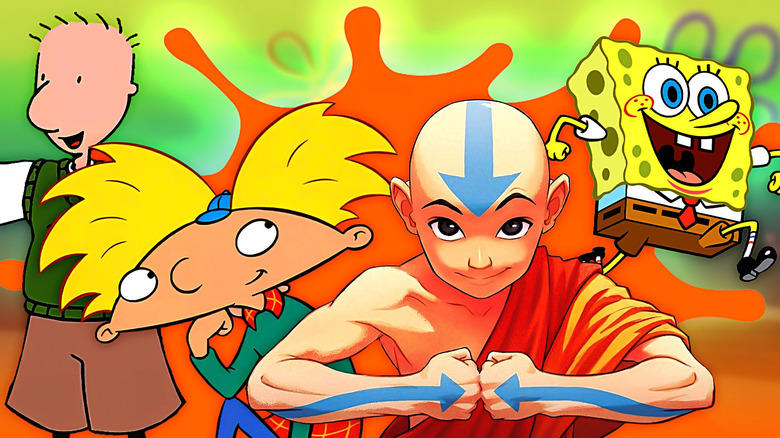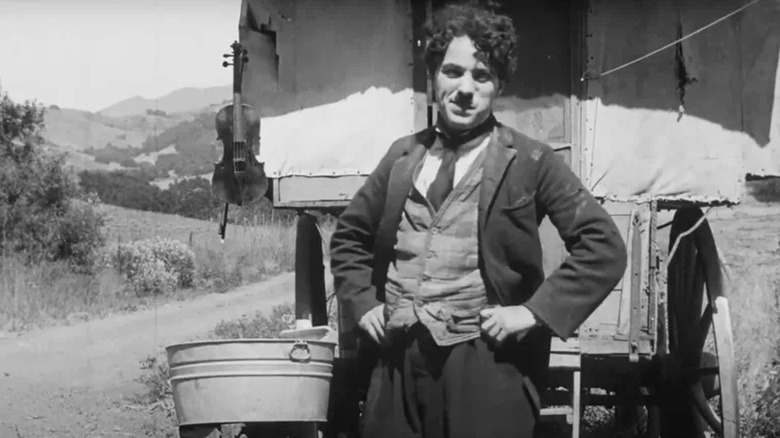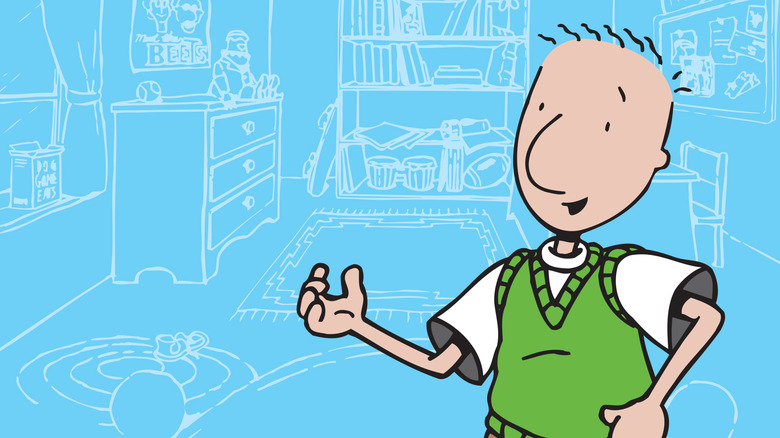What Does Nickelodeon Mean? The Name Of The TV Channel, Explained
We may receive a commission on purchases made from links.
Many of the famous children's television shows of the past few decades, from the silly "Spongebob Squarepants" to the more serious and ambitious "Avatar: The Last Airbender," share a home: Nickelodeon, often called simply "Nick."
Nickelodeon is distinguished by its orange splatter logo (designed by Tom Corey & Scott Nash) and its variety of programming. Kids are not a monolith, so Nickelodeon has sister channels and programming blocks to appeal to different niches (Nick Jr. for the preschoolers, Nick at Nite for the older kids, etc). You'd be unlikely to see anything as edgy as Adult Swim's programming on Nick at Nite, but it still targets viewers who've long aged out of shows aimed at extremely young kids, like "Blue's Clues."
But what is a "Nickelodeon"? You may have seen viral social media posts claiming that the word is Latin for "I don't care about God," but those claims are nonsense.
When I was a kid, I just accepted the name "Nickelodeon" as referring to the TV channel and never knew about its origin. There's a good reason for that knowledge gap: A "Nickelodeon" was a type of movie theater in the early 1900s, when film was still a young art form. So the name comes from an era long before Nickelodeon's target audience was alive and refers to something that no longer exists. But Nickelodeon the channel has been around for almost 50 years and usurped the meaning of its name in the popular consciousness, so clearly, someone had the right idea with that branding.
Nickelodeon is named after an old type of movie theater
In 1896, audiences reportedly recoiled when watching Auguste and Louis Lumière's minute-long film "The Arrival of a Train at La Ciotat." According to the legend, people weren't used to moving images, and they thought the train moving forward on the screen meant the train was about to run them over. Over the next decade, people got more and more used to how movies worked. By 1905, you could run a screening venue for movies as a healthy business with a reliable customer base.
These early theaters were called nickelodeons. The name is a portmanteau. The theaters would typically charge a nickel for admission, and "odeon" is a Greek/Roman word for a theater.
Nickelodeons were the original movie theaters, defining the dominant form of film exhibition for the next century. That dominant form being that filmmakers would (originally through film exchanges) rent out their movies to theaters for distribution, ensuring that theaters had a constant stream of new attractions to keep audiences coming back.
Several future Hollywood studio bosses, such as William Fox (founder of the Fox Film Corporation, which became 20th Century Fox) and Louis B. Mayer (co-founder of MGM), owned nickelodeons in those days. The experience gave them an early foothold in the movie business, resulting in the major studios that still dominate the industry today. As film historian Charles Musser once wrote, "It is not too much to say that modern cinema began with the nickelodeon."
The history of TV channel Nickelodeon begins decades after nickelodeon venues went out of fashion. The story begins in 1977 with the children's TV series "Pinwheel," a Muppet-like show that combined puppets and live actors. The series was created by Dr. Vivian Horner and produced by Sandy Kavanaugh, who had both previously worked at the Children's Television Workshop (producers of "Sesame Street").
Nickelodeon was the first children's cable channel
"Pinwheel" aired on the Columbus, Ohio channel QUBE before expanding nationwide as part of the new Nickelodeon channel in 1979. Reportedly, Kavanaugh (who became Nick's first director of programming) is the one who came up with the name "Nickelodeon." Interviewed for Mathew Klickstein's 2013 book "Slimed!: An Oral History of Nickelodeon's Golden Age," Kavanaugh recalled:
"The first word my daughter ever read was 'Nickelodeon.' She pointed to it on a T-shirt and said, 'Nickanee!' It's been there for her [during] her whole life."
One of the major innovations of Nickelodeon was that it was a cable network targeted at kids. Revenue didn't come from advertising, but from cable providers paying to carry the channel — 10 cents each for every household reached. Speaking to The New York Times when Nick first launched in 1979, Horner said this model would ensure Nick would prioritize being kid-friendly above being commercial:
"The pace is different, slower, gentler. There is none of the bang‐bang‐bang that the commercial people think necessary to catch and hold attention. The programming [is] made up of varied materials of varying lengths, so that none of it begins or ends on the hour. I think of it as an electronic sandbox the kids can come to whenever they wish."
This probably doesn't sound like the Nickelodeon you know, and for good reason. According to the 2004 book "Nickelodeon Nation: The History, Politics, and Economics of America's Only TV Channel for Kids," the no-ads model wasn't financially sustainable, so Nick introduced advertising in 1983 and then commercial spots in 1984. By 1985, Nickelodeon had become profitable; Horner had also left and the channel had been sold to Viacom. Nickelodeon remains under that corporate umbrella (now called Paramount Global) to this day. Geraldine Laybourne, who was president of Nickelodeon from 1984 to 1996, is credited by many (including Horner) with creating the modern and edgier Nick.
"[Laybourne's] Nickelodeon has an attitude, like Angelica from 'Rugrats," Horner told Forbes in 1999. "I appreciate it, but I like softer programming myself. I'm a bit old-fashioned. I'm not sure if I could have made Nickelodeon such a big hit."
Laybourne's tenure is when Nickelodeon started to diversify into different programming blocks, and when many of its famous and best-remembered shows ("Rugrats," "Doug," etc.) began. Today, original cartoons ("Spongebob" especially) are the backbone of Nickelodeon.
That's not to say Nickelodeon's history is all hunky dory. See: the 2024 documentary "Quiet on Set: The Dark Side of Kids TV." This doc revealed disgusting details about working conditions on the productions of Nickelodeon's live-action comedy programs (many created/overseen by producer Dan Schneider) during the 1990s and 2000s. Drake Bell, star of Schneider's sitcom "Drake & Josh," revealed he had been groomed and repeatedly sexually assaulted by acting and dialogue coach Brian Peck during this time.
The legacy of Nickelodeon in the memories of children (including those who've since grown up) is undeniable, but it's also important to never forget the unflattering parts of any storied history.


